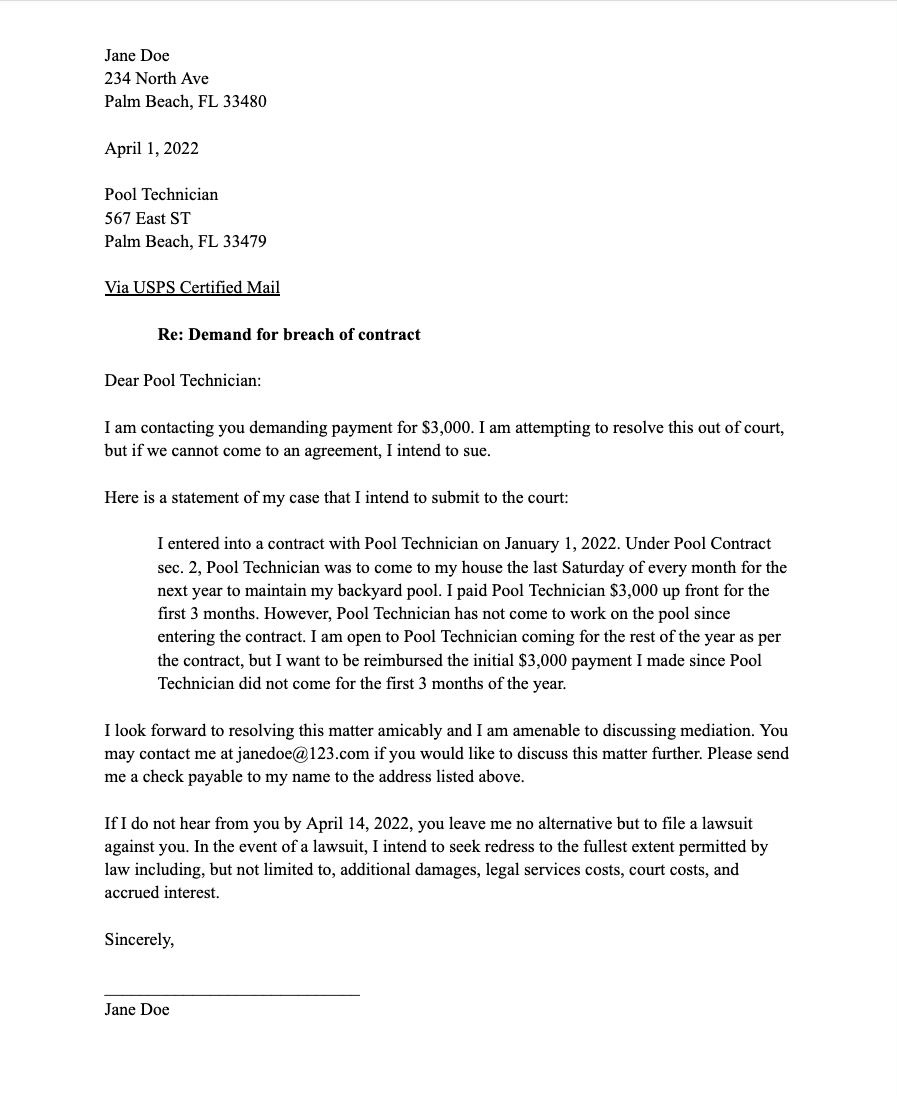Contents
You enter into contracts every day without even realizing it. So what do you do when, inevitably, one of those contracts gets broken? The good news is you have the option to take the party that broke the contract to small claims court. You can also write a breach of contract demand letter. In this article, learn what a demand letter is, why sending a demand letter is beneficial, and how to write a breach of contract demand letter.
Looking to send a demand letter? Request an attorney demand letter or use our free demand letter template to write one.
Get Started ➜Common Types of Demand Letters for Breach of Contract 
A breach of contract demand letter puts the other party on notice that you intend to sue because they violated the terms of your agreement or contract. There are many different types of cases that would require a breach of contract demand letter.
Here are examples of breach of contract demand letters:
You agreed to work as a general contractor for a homeowner and enter into a contract. The contract said you would be paid progress installments, but the homeowner never pays any of the installments. Read more about Theft of services.
You agreed to babysit your neighbor's kids every Friday night for a month. You showed up on the last Friday night as scheduled, but your neighbor now says they do not need your services anymore.
You enter into a consulting agreement with a big corporation. Based on the agreement you would be paid at the end of the project. However, the big corporation never pays you for your consulting services.
You lent your roommate money for rent. They promised to repay you in a few months once they started a new job. Your roommate starts the new job but they never pay you back.
Why is a Demand Letter for Breach of Contract Important 
Here are four reasons why sending a demand letter for breach of contract is important:
Depending on what state you are filing a small claims court lawsuit in, you may be required to demand payment before filing. Demand letters are an effective way of completing this requirement.
They signal to the party you contracted with that you are serious about the problem and are willing to spend time and money to get your money back.
A demand letter allows the party to resolve the dispute without resorting to legal action, like bringing a lawsuit in small claims court.
Remember, in most small claims courts, you can only ask for monetary damages. This means if you win the lawsuit, the court is only going to award you money; the court cannot make the other party do something. However, in a demand letter, you can ask for any type of relief you want. So, if the dispute is over services not rendered, let the other party know you are willing to settle the dispute if they provide the services on a different date.
What to do Before Writing a Demand Letter for Breach of Contract 
Before you write your demand letter for breach of contract, review the contract or agreement.
What to look for when you are reviewing a contract:
What was the other person supposed to do under the contract?
This is important to consider before you start writing your demand letter for breach of contract. In the demand letter, you want to explain exactly how the other party breached the contract. Reviewing your contract or agreement beforehand will make your argument more persuasive and coherent.
Did the other person do what they were supposed to do under the contract?
Here is where you are outlining what the "breach" of the contract is. What was the person supposed to do under the contract and what did the person do instead? For example, if you entered into a contract whereby the other party was supposed to paint your living room and never showed up to paint, they breached the contract.
What are the money terms?
For example, how much were you supposed to pay the other party for their work, and how were they supposed to get paid?
What dates are involved?
For example, were there any deadlines included in the contract? Were the deadlines met, or did the other party break the deadline set in the contract?
What happens if the contract is not in writing?
In general, a contract does not need to be in writing for it to be enforceable. If you and someone else agreed verbally, that is still a contract. Make sure to write down or save any information that relates to the verbal agreement.
Read More: Tips on how to write a demand letter.
What to Include in a Demand Letter for Breach of Contract?
Writing a demand letter may seem very complicated, but we have added a list of suggestions for you to consider when writing your breach of contract demand letter.
Here are a few suggestions of what to include in your demand letter:
List the portions of the original contract or agreement that are relevant to the demand letter. For example, if you are writing a demand letter to your landscaper because they did not perform the services required on the date specified on the contract, add the exact language or portion of the contract that was violated.
Include how much money you are owed. For example, how much money did you pay under the contract?
Include your contact information so the party you contracted with can reach you in case there are follow-up questions. We recommend that you provide your email address at least.
Include where you would like to receive payment. For example, if a business owes you money, they will probably send you the money via a check. Consider adding your address so they can mail the check to you.
Include a deadline to respond to you. You may want to consider giving the other party 7-14 days to respond to you and state that if they do not respond within that time, you intend to sue them.
Sample Demand Letter for Breach of Contract 
Here is a video on how our demand letter tool works:
Below is a sample demand letter for breach of contract to help you construct your own demand letter. This template can be easily modified for your particular situation. In this sample demand letter, the dispute is between a homeowner and a pool technician over services not rendered under the contract. Make sure your demand letter for breach of contract discusses your particular situation with case-specific details.

With our letter service, we ship your letter for you using Certified or Priority Mail.
Get Started ➜How to Send a Demand Letter for Breach of Contract 
We recommend you send your demand letter for breach of contract via email or mail. For letters that you mail, consider the following:
Tracking. Make sure to track your demand letter. With tracking, you will know if the letter reached the other party’s mailbox.
Signature Required. You do not necessarily need a signature request. When you send a letter with the receiver's signature requested, the postal carrier must hand-deliver the letter and the person must sign for the letter. If you are sending this letter to an individual, it can be difficult for the post office to obtain the signature.
We don't recommend sending demand letters to individuals at a home address with a signature required. A signature required mailing does work better when you send the letter to a business that is open during regular delivery hours.
Once you have sent your demand letter for breach of contract, keep it for your records. You can bring it to the small claims court hearing and show it to the judge (especially if the person you are suing claims they didn't receive the letter).
Continue Reading: When to send a demand letter vs suing in small claims.
Next Steps After Sending a Demand Letter for Breach of Contract 
What happens when the other party defaults or fails to meet the demands in your breach of contract demand letter? Consider filing a lawsuit in small claims court.
Small claims courts handle a wide variety of breach of contract lawsuits. This includes lawsuits between roommates over rent payments, lawsuits between individuals and businesses, and lawsuits for services not rendered.
Read More: What to do if someone breaks a contract.

Camila Lopez, Esq.
Attorney at JusticeDirect. Camila holds a law degree and is a certified mediator. Her passion is breaking down complicated legal processes so that people without an attorney can get justice.

